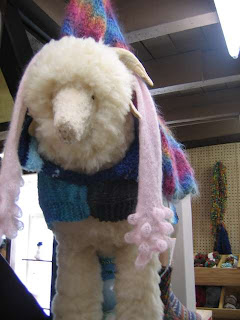Casting On with Two Balls
After knitting up the original swatch for the Alice Starmore's Rosemarkie vest, my wife and I both came to realize that the dark grey for the main color was way too dark. So we dropped back 10 yards and punted, and she found some very nice light-colored lavender yarn that's an alpaca and cotton blend. The new swatch looks great!

This is actually swatch #3. Swatch 1's colors were wrong, and swatch 2's gauge wasn't close enough. After a good washing and blocking, this comes out to just over 7 st/inch. It's supposed to be 7.75 st/inch, but if I knit the smallest size listed, it will work out to be the right size. So this is great news, as this means fewer stitches!
So I started to cast on 304 stitches tonight, and when I got to about stitch 200, I realized that I didn't have nearly enough tail! Big crapola there. Then I remembered reading online somewhere about using two balls of yarn to do a long tail cast on. After a few searches on Google, I remembered that it was The Knitting Geek who instructed me how to do it. After much fiddling with the yarn, I figured it out.
First, tie a loose overhand knot onto the needle for each yarn end and stick the two ends together on the needle, holding them together with your thumb and index finger (if that makes you feel more secure). Pick one of the yarns to be the "tail," then cast on as you would for a long-tail (or variant, like Twisted German). When you've cast on the required number of stitches, cut the "tail" yarn, leaving enough of an end to weave in, and unpick the overhand knots. You have a few more ends to weave in than you normally would, but it's a small price to pay, especially when you consider the hundreds of stitches you might otherwise have to undo (if you miscalculate the tail length).
My wife has dubbed this technique the Male Cast On. Why? Because you need two balls to do it.

This is actually swatch #3. Swatch 1's colors were wrong, and swatch 2's gauge wasn't close enough. After a good washing and blocking, this comes out to just over 7 st/inch. It's supposed to be 7.75 st/inch, but if I knit the smallest size listed, it will work out to be the right size. So this is great news, as this means fewer stitches!
So I started to cast on 304 stitches tonight, and when I got to about stitch 200, I realized that I didn't have nearly enough tail! Big crapola there. Then I remembered reading online somewhere about using two balls of yarn to do a long tail cast on. After a few searches on Google, I remembered that it was The Knitting Geek who instructed me how to do it. After much fiddling with the yarn, I figured it out.
First, tie a loose overhand knot onto the needle for each yarn end and stick the two ends together on the needle, holding them together with your thumb and index finger (if that makes you feel more secure). Pick one of the yarns to be the "tail," then cast on as you would for a long-tail (or variant, like Twisted German). When you've cast on the required number of stitches, cut the "tail" yarn, leaving enough of an end to weave in, and unpick the overhand knots. You have a few more ends to weave in than you normally would, but it's a small price to pay, especially when you consider the hundreds of stitches you might otherwise have to undo (if you miscalculate the tail length).
My wife has dubbed this technique the Male Cast On. Why? Because you need two balls to do it.

Comments
All joking aside, that's a great swatch! Any photos of the rejects?
The two ball technique is really easy, actually. Just tie a loose overhand knot for each end over the needle, stick the two ends together, pick one to be your "tail," then cast on like normal. Unpick the overhand knots when you're done.
And I wouldn't say I've "moved on" from socks. Socks will always be there for me, I'm sure. I just thought this looked like an adventure.